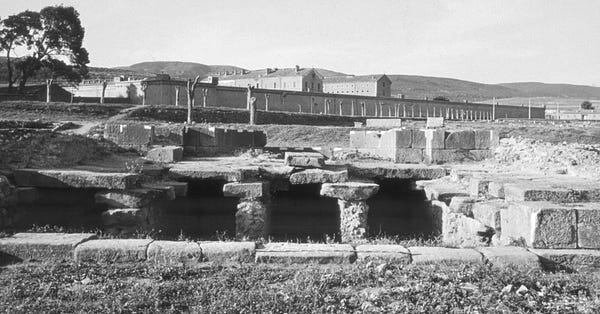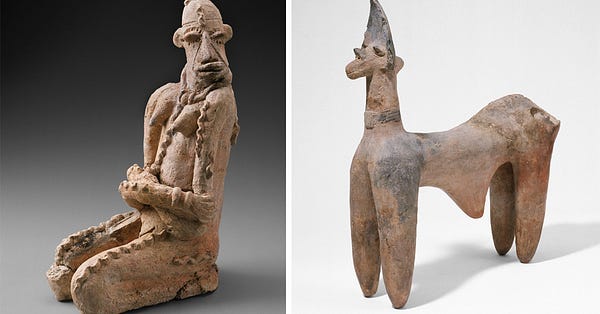
This week, Mark Letteney discusses ancient prisons and the study of incarceration within the premodern Mediterranean. Then, Ukrainian museums look to protect their employees and their collections, an ancient Greek version of Wordle, ISAW-NYU’s “Pompeii in Color” opens to the public, a study of ancient alcohol in the Andes, and more.
Across the ancient Mediterranean world, prisons were ubiquitous. Writing in the late first century BCE, the Roman architect Vitruvius prescribes that the forum of every Roman city should have three things: a meeting house, a treasury, and a prison, each in proportion to the size of the forum and, by general extension, the population of the town. (On Architecture 5.2.1) Some 150 years before, in Ptolemaic Egypt, even mid-sized towns like Krokodilopolis apparently had multiple carceral spaces, such that one could be nick-named ‘Big Prison.’ Roman and especially early Christian sources refer to several different types of prisons dotting the ancient landscape, distinguished not by the kinds of people that they held, but by the authority under which bodies were imprisoned. In the Acts of Perpetua and Felicity, for instance, after house arrest early third century Christian martyrs were apparently shuffled between prisons of three different types: a civic prison, a military prison, and an amphitheater prison, each of which are attested in the archaeological record (Letteney and Larsen 2021). Even so, incarceration has received scant attention by ancient historians, and the treatments that do exist tend to focus on one type of evidence — literature, documents, archaeology, or art.
As a general rule, historians don’t look for ancient prisons because they don’t think there are any to be found. Critical prison studies is a new and rapidly growing field, whose origins are inflected by Michel Foucault’s landmark 1975 publication, Discipline and Punish: The Birth of the Prison. As the subtitle suggests, Foucault argued that the prison was “born” in the 18th and 19th centuries, in Europe and the US. Historians have recognized that ancient societies had sites called “prisons,” but to date most historians regard such places as mere pits or dungeons, wholly removed from broader social, political, and bureaucratic systems. This idea, that ancient prisons were marginal and disconnected, comes from Theodor Mommsen — perhaps the “father” of modern Classics — who used prescriptive legal sources to describe Roman social practice. In 1899 he argued that Romans did not use prisons for punishment, but rather solely as a place of brief pre-trial detention: as a jail, in modern parlance. Mommsen’s proposal was so influential that, for the better part of the 20th century, questions about the role of prisons in the ancient Mediterranean world remained unasked and unanswered.
Yet, even Roman jurists like Ulpian, who lamented incarceration as a punishment for convicted criminals — penal incarceration — attest to its widespread use (Digest 48.19.8.9). In 320 CE, a law of Constantine made judicially clear what was already widely practiced, at least as far as we can see in the 250 or so documents related to incarceration that Matthew D C Larsen and I have collected in preparation for our forthcoming Ancient Mediterranean Incarceration (University of California Press). Constantine ordered “Prisons are for punishment; prisons are for guilty people.” (Theodosian Code 11.7.3).
It is not only that legal sources prescribe prisons as punishment, but people in antiquity experienced their incarceration as punishment in and of itself. From the third century BCE through the sixth century CE in Egypt, countless people spent interminable stretches in prison without recourse to any legal or social networks of support. Consider, for instance, BKU 1.144, a late ancient letter from a prisoner, written in Coptic on a small piece of broken pottery. The prisoner’s short letter concludes simply, “I am dying in prison and I don’t know why.” Prisoners languished for years waiting for trial, and their letters indicate that many experienced their time in prison as a punishment in and of itself. The modern case of Kaleif Browder is illustrative: a sixteen-year-old kid was held in custody at Rikers Island for three years, without conviction of a crime. It is perhaps theoretically true that his years of incarceration were not meant as punishment, given that he was never convicted of the accused crime. It is little comfort to someone serving an indeterminate jail sentence pending trial that they are not, technically being punished.
Didier Fassin’s recent, influential Prison Worlds begins with the assertion “Prison is a recent invention.” (Fassin 2016) If this common notion is false, then a new framework is needed in efforts to mobilize history in our attempt to move beyond our era of mass incarceration. Incarceration was a persistent social reality throughout antiquity, and like today, its ubiquity rendered it nearly transparent.
Bibliography:
Cadoux, T. J. “The Roman Carcer and Its Adjuncts.” Greece and Rome 55, no. 2 (2008): 202–21. https://doi.org/10.1017/S0017383508000533.
Cobb, L. Stephanie. “From Prison to Palace: The Carcer as Heterotopia in North African Martyr Accounts.” In Desiring Martyrs, edited by Harry O. Maier and Katharina Waldner, 137–54. De Gruyter Oldenbourg, 2020. https://doi.org/10.1515/9783110682632-008.
Folch, Marcus. “Political Prisoners in Democratic Athens, 490–318 BCE Part II: Narrating Incarceration in Athenian Historiography and Oratory.” Classical Philology 116, no. 4 (2021): 498–514. https://doi.org/10.1086/716016.
Foucault, Michel. Discipline and Punish: The Birth of the Prison. 1st American ed. New York: Pantheon Books, 1977.
Fuhrmann, Christopher J. Policing the Roman Empire: Soldiers, Administration, and Public Order. Oxford: Oxford University Press, 2012.
Gould, Rebecca. “Prisons before Modernity: Incarceration in the Medieval Indo-Mediterranean.” Al-Masāq 24, no. 2 (2012): 179–97. https://doi.org/10.1080/09503110.2012.684759.
Hillner, Julia. “Female Crime and Female Confinement in Late Antiquity.” In Social Control in Late Antiquity, edited by Kate Cooper and Jamie Wood, 15–38. Cambridge University Press, 2020. https://doi.org/10.1017/9781108783491.004.
———. Prison, Punishment and Penance in Late Antiquity. New York: Cambridge University Press, 2015.
Larsen, Matthew D. C. “Carceral Practices and Geographies in Roman North Africa.” Studies in Late Antiquity 3, no. 4 (December 1, 2019): 547–80. https://doi.org/10.1525/sla.2019.3.4.547.
Letteney, Mark, and Matthew D. C. Larsen. “A Roman Military Prison at Lambaesis.” Studies in Late Antiquity 5, no. 1 (2021): 65–102. https://doi.org/10.1525/sla.2021.5.1.65
Muhs, Brian. “Imprisonment, Guarantors, and Release on Bail in the Ptolemaic Fayum.” In Le Fayoum: archéologie - histoire - religion: actes du sixième colloque international, Montpellier, 26-28 octobre 2016, edited by Marie-Pierre Chaufray, Ivan Guermeur, Sandra L. Lippert, and Vincent Rondot, 89–99. Wiesbaden: Harrassowitz Verlag, 2018.
Sijpesteijn, Petra. “Policing, Punishing and Prisons in the Early Islamic Egyptian Countryside (640–850 CE).” In Authority and Control in the Countryside, edited by Alain Delattre, Marie Legendre, and Petra Sijpesteijn, 547–88. Leiden: Brill, 2018. https://doi.org/10.1163/9789004386549_019.
To learn more, tune in for a talk from Mark Letteney and Matthew D.C. Larsen on March 29, 2022 at 6:30 pm ET. Register here.


Public Scholarship on the Web
As the world follows the events of the illegal invasion of Ukraine, stopping the loss of human life is the most important priority. Ukrainian cultural institutions are also working tirelessly to protect their collections. As news broke that the Ivankiv Historical-Cultural Museum was destroyed by Russian troops on Tuesday, museum workers in neighboring countries have been creating evacuation plans for museum employees and the objects they oversee:
The International Council of Museums (Icom) Polish branch has been asked by the Polish Ministry of Culture to coordinate evacuation plans for museum employees from Ukraine, and an emergency meeting is taking place today to discuss the evacuation of objects…Meanwhile staff and the National Museum in Warsaw are coordinating efforts to welcome the families of employees from the National Gallery of Art in Lviv, with whom the Polish institution has a close relationship. They have also sent a van from the museum with supplies of non-perishable goods for those remaining behind. The Museum of Warsaw has an active refugee programme in place to support former museum employees and is working to welcome families to Warsaw.
Polin Museum of the History of Polish Jews has sent two transports of goods to Ukraine. Financial support for these efforts is being channelled through the Polish Red Cross.
We just want you to know that there is an ancient Greek version of Wordle. Of course, the brilliant Helma Dik of Logeion fame helped with the translation.
At Hyperallergic, Cassie Packard discusses the news that two ancient Djenné terracotta figurines believed to be illicitly removed and trafficked in the 1980s, will return to Mali. The Museum of Fine Arts, Boston (MFA) are sending the 13th-15th century figurines, given to the museum along with over 300 items when “a collector of African art and owner of University Prints” named William Teel died.


In other museum news, the exhibition “Pompeii in Color” at ISAW-NYU (near the Met in NYC) is now open to the public. So many Pompeiian frescoes!
In the journal Antiquity, Matthew E. Biwer, Willy Yépez Álvarez, Stefanie L. Bautista and Justin Jennings publish their findings on “Hallucinogens, alcohol and shifting leadership strategies in the ancient Peruvian Andes.”
In the pre-Columbian Andes, the use of hallucinogens during the Formative period (900–300 BC) often supported exclusionary political strategies, whereas, during the Late Horizon (AD 1450–1532), Inca leaders emphasised corporate strategies via the mass consumption of alcohol. Using data from Quilcapampa, the authors argue that a shift occurred during the Middle Horizon (AD 600–1000), when beer made from Schinus molle was combined with the hallucinogen Anadenanthera colubrina. The resulting psychotropic experience reinforced the power of the Wari state, and represents an intermediate step between exclusionary and corporate political strategies. This Andean example adds to the global catalogue documenting the close relationship between hallucinogens and social power.

Upcoming Conferences and Lectures
From March 31-April 2, 2022 is the '“Dura-Europos: Past, Present, Future” conference celebrating the centennial of excavations at Dura-Europos. You can register here to attend online and hear a broad range of papers. If you are at Yale, you may also register to attend in person.
On March 8, 2022 at 4:30 pm EST, Joseph Howley will be speaking at Rutgers Classics on “Slavery & the Book.” You can register here.


And next week, Byzantine Dialogues from the Gennadius Library presents "The Residue of Eden: Myth and Medicine in Early Christian Anointing Practices,” given by John Penniman on Tuesday, March 8, 2022, 7 p.m. EET (Greece) / 12 p.m. EST:
Olive oil was one of the most popular pharmacological substances in the ancient Mediterranean world. It appears pervasively in medical handbooks, magical incantations, cultic healing rituals, hygiene guidelines, and accessories for personal adornment. As a drug (pharmakon) with wide application, olive oil provides an interesting case study for exploring the borderlands between religious ritual and medical regimen. In "The Residue of Eden," Professor John Penniman of Bucknell University will offer a re-interpretation of the literary and material evidence surrounding early Christian anointing practices in light of the pharmacological power of olive oil.
More information & registration here.
New Online Journal Issues @YaleClassicsLib
Études et Travaux Vol. 34 (2021)
Anzeiger für die Altertumswissenschaft Vol. 74, No. 3 (2021) #openaccess
Enoch Seminar Newsletter Vol. 6, No. 2 (February 2022)
International Journal of Cultural Property Vol. 28, No. 3 (2021)
Zeitschrift für die neutestamentliche Wissenschaft Vol. 113, No. 1 (2022)
Journal for the Study of the Historical Jesus Vol. 20, No.1 (2022)
Pitches
The Public Books section "Antiquities" continues to take pitches for articles to be published in 2022. You can pitch to our “Pasts Imperfect” column at the LA Review of Books using this form and to the new JSTOR column here. Thanks for reading!












